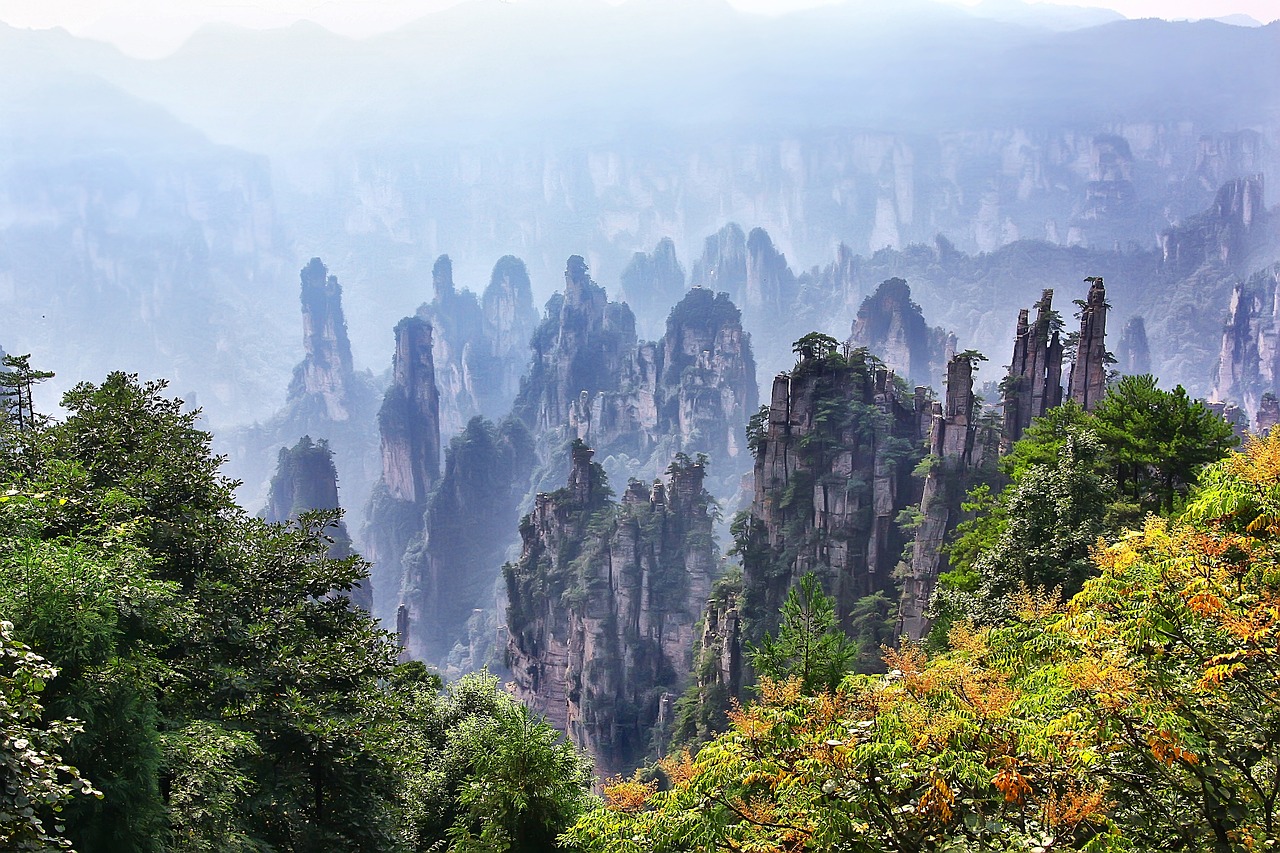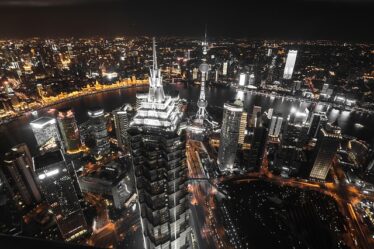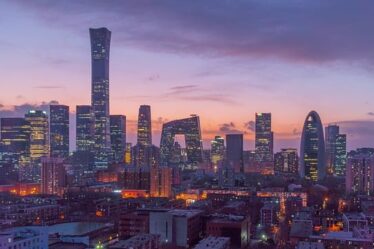
Zhangjiajie National Forest Park, located in the Hunan Province of China, is renowned for its towering sandstone pillars, lush greenery, and breathtaking landscapes. Often referred to as the inspiration for the floating Hallelujah Mountains in the movie “Avatar,” this UNESCO World Heritage site is a must-visit destination for nature lovers, adventure seekers, and photographers. This detailed guide covers everything you need to know about visiting Zhangjiajie National Forest Park, from its natural wonders and outdoor activities to practical travel tips and cultural highlights.
Geographical and Historical Overview
Geography of Zhangjiajie National Forest Park
The park is part of the larger Wulingyuan Scenic Area, which encompasses over 26,000 hectares of striking karst landscapes, dense forests, and deep ravines. Zhangjiajie National Forest Park is known for its unique quartz-sandstone formations, with more than 3,000 narrow, pillar-like peaks that rise dramatically from the valley floor. These formations have been shaped by millions of years of geological processes, including erosion and weathering.
Historical Significance
Zhangjiajie National Forest Park was established in 1982 as China’s first national forest park. In 1992, the Wulingyuan Scenic Area, including Zhangjiajie, was designated a UNESCO World Heritage site due to its exceptional natural beauty and geological significance. The park has a rich cultural heritage, with a history that includes ancient indigenous tribes, traditional Chinese folklore, and the influence of Taoist philosophy.
Visitor Information
Getting There
Zhangjiajie is accessible by various means of transportation:
- By Air: Zhangjiajie Hehua International Airport (DYG) has flights from major Chinese cities such as Beijing, Shanghai, Guangzhou, and Xi’an. The airport is about 30 kilometers from the park.
- By Train: Zhangjiajie Railway Station connects the city to major destinations across China. High-speed trains are available from Changsha, the capital of Hunan Province.
- By Bus: Long-distance buses operate from nearby cities like Changsha, Wuhan, and Guangzhou to Zhangjiajie.
Best Time to Visit
- Spring (April to June): Mild temperatures and blooming flowers make spring an ideal time to visit. The weather is comfortable for hiking and outdoor activities.
- Autumn (September to November): Cooler temperatures and clear skies offer excellent visibility of the park’s stunning landscapes. Autumn foliage adds vibrant colors to the scenery.
- Summer (July to August): Warm and humid, but the park’s lush greenery is at its peak. Expect larger crowds due to the school holidays.
- Winter (December to February): Cold and less crowded, with occasional snowfall transforming the park into a winter wonderland. Some trails may be closed due to ice and snow.
Exploring Zhangjiajie National Forest Park
Natural Wonders
- Avatar Hallelujah Mountain: Originally named the Southern Sky Column, this iconic peak inspired the floating mountains in the movie “Avatar.” It offers a stunning view and is one of the park’s main attractions.
- Tianzi Mountain: Known as the “Monarch of the Peak Forest,” Tianzi Mountain offers panoramic views of the surrounding peaks and valleys. The area is accessible by a cable car that provides a scenic ride to the top.
- Yuanjiajie Scenic Area: This area features some of the park’s most famous rock formations, including the First Bridge Under Heaven and the Avatar Hallelujah Mountain. The Bailong Elevator, a glass elevator built into the side of a cliff, provides a thrilling ride with breathtaking views.
- Golden Whip Stream: A picturesque stream that winds through a lush valley surrounded by towering peaks. The trail along the stream is relatively easy and offers beautiful scenery, making it popular for leisurely walks and picnics.
Outdoor Activities
- Hiking: The park offers a variety of hiking trails, ranging from easy walks to challenging treks. Some popular trails include the Golden Whip Stream Trail, the Tianzi Mountain trails, and the paths around Yuanjiajie.
- Cable Cars and Elevators: Several cable cars and elevators provide access to different parts of the park, offering stunning aerial views. The Bailong Elevator and the Tianzi Mountain Cable Car are among the most popular.
- Glass Bridge: The Zhangjiajie Grand Canyon Glass Bridge is the longest and highest glass bridge in the world, spanning a deep canyon. Walking across the bridge offers thrilling views of the canyon floor far below.
- Photography: The unique landscape of Zhangjiajie makes it a paradise for photographers. Early morning and late afternoon offer the best lighting for capturing the dramatic peaks and mist-shrouded valleys.
Cultural Heritage
Local Culture
The region is home to several ethnic minority groups, including the Tujia and Miao people, who have a rich cultural heritage and traditional customs. Visitors can explore local villages, attend traditional performances, and learn about the indigenous way of life.
- Tujia Folk Custom Park: This cultural park showcases traditional Tujia architecture, crafts, and performances. It provides an opportunity to learn about the history and customs of the Tujia people.
- Xibu Street: Located in Wulingyuan, this vibrant street offers a mix of traditional shops, restaurants, and cultural performances. It’s a great place to sample local cuisine and buy handicrafts.
Practical Travel Tips
Accommodation
Zhangjiajie offers a range of accommodation options to suit different budgets and preferences:
- Luxury Hotels: Several high-end hotels in Wulingyuan and Zhangjiajie city offer comfortable accommodations with modern amenities. Some popular options include the Pullman Zhangjiajie Hotel and the Crowne Plaza Zhangjiajie Wulingyuan.
- Mid-Range Hotels: There are many mid-range hotels and guesthouses that provide comfortable rooms and convenient locations. The Zhangjiajie Huatian Hotel and the Wulingyuan Resort are good choices.
- Budget Options: Budget travelers can find affordable guesthouses and hostels in Wulingyuan and Zhangjiajie city. These accommodations offer basic amenities and are often located near the park entrance.
Transportation
- Park Shuttle Buses: The park operates a shuttle bus system that connects the main entrances and scenic areas. The buses are convenient and included in the entrance fee.
- Cable Cars and Elevators: Several cable cars and elevators provide access to different parts of the park, offering stunning aerial views.
- Private Transportation: Hiring a private car or taxi can be convenient for exploring the park at your own pace. Many hotels offer transportation services.
What to Pack
- Comfortable Clothing: Dress in layers to accommodate changing temperatures. Wear comfortable hiking shoes for exploring the trails.
- Rain Gear: The weather in Zhangjiajie can be unpredictable, so bring a rain jacket or poncho.
- Camera Gear: The stunning landscapes make Zhangjiajie a photographer’s paradise, so don’t forget your camera, extra batteries, and memory cards.
- Snacks and Water: Bring snacks and water for the day, as some areas of the park may not have convenient access to food and drink.
Nearby Attractions
Tianmen Mountain
Tianmen Mountain, located near Zhangjiajie city, is known for its stunning scenery and thrilling attractions:
- Tianmen Cave: Also known as the “Heavenly Gate,” this natural archway is a popular attraction. A long staircase leads to the cave, offering spectacular views.
- Glass Skywalk: The glass walkway clings to the side of the mountain, providing a thrilling experience with breathtaking views of the valley below.
- Tianmen Mountain Cableway: One of the longest cableways in the world, offering a scenic ride to the top of the mountain.
Baofeng Lake
Baofeng Lake is a serene and beautiful lake surrounded by lush mountains. Boat tours offer a relaxing way to enjoy the scenery and learn about local legends and folklore.
Conclusion
Zhangjiajie National Forest Park is a destination that promises an unforgettable experience. From its otherworldly landscapes and ancient history to its vibrant culture and outdoor adventures, Zhangjiajie offers something for every traveler. Whether you’re hiking through scenic trails, soaring above the peaks in a cable car, or exploring the cultural heritage of the local people, Zhangjiajie is sure to leave you with lasting memories. Plan your visit to this magical region and discover why it is one of China’s most beloved natural treasures.

